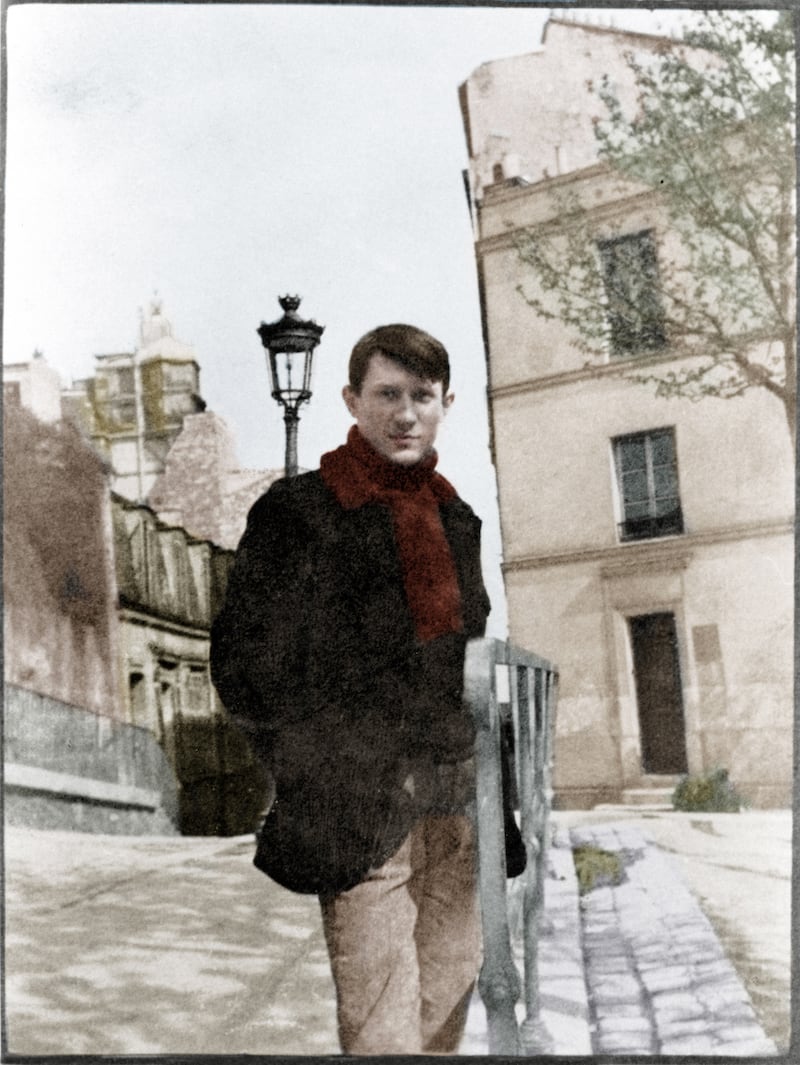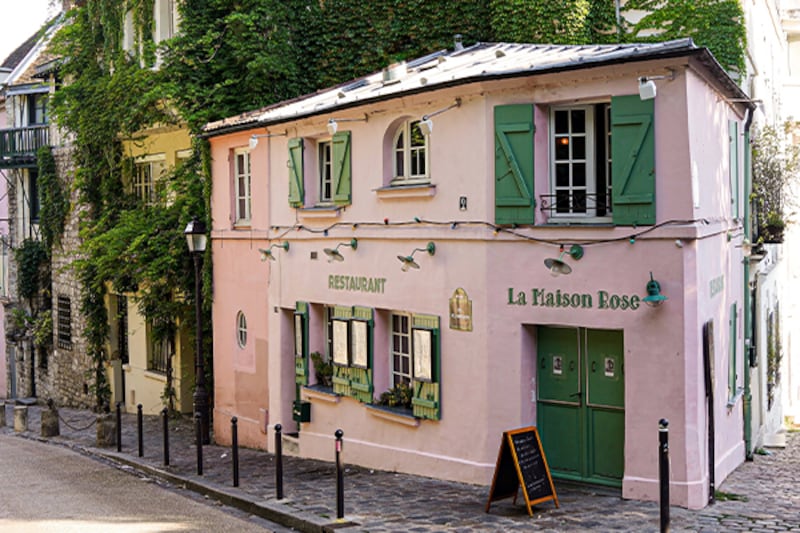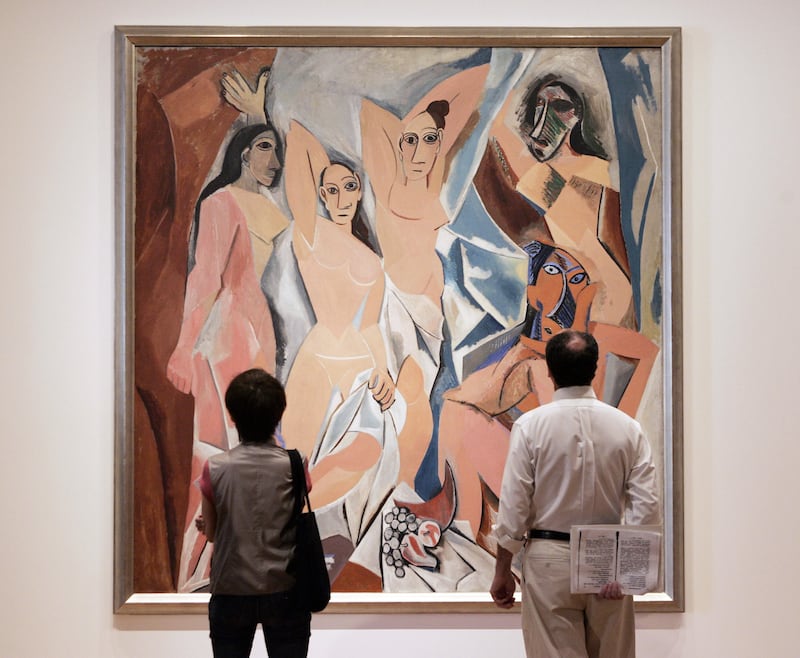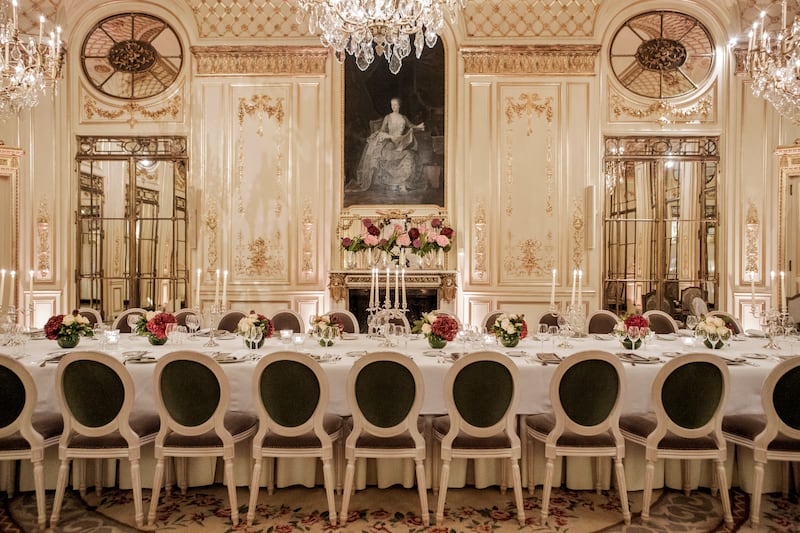Pablo Picasso’s paintings were not selling in the winter of 1902-1903. The young artist was cold and hungry. His Parisian dream seemed to shatter, and he was forced to return penniless to Barcelona, where, supreme humiliation, he had to move back in with his parents.
“Mama, where is my suit?” Pablo cried out one morning. She was cleaning it, María Picasso y López replied. “Oh no!” he shouted. “You must not! That suit smells of Paris!”
The anecdote is told by Marta-Volga de Minteguiaga-Guezala, known in the art world as Marta. The genial art historian is the soul of Le Meurice hotel’s Picasso package, which gives affluent visitors the chance to immerse themselves in Picasso’s formative years in Montmartre.
Le Moulin de la Galette is still a restaurant, though working class locals and prostitutes long ago gave way to more affluent customers
Picasso was doubtlessly the most fearless and constantly innovative – many would say the greatest – artist of the 20th century, so it is difficult to imagine him in despair. “He certainly went through difficult periods, like the winter of 1902-03,” says Marta. “But he never doubted that he was a great artist.”
Clairo at 3Olympia: Whispery vocals and piano licks make a seamless transition from bedroom to jazz club
‘I am at a loss as to how €5,200 goes missing’: PTSB customers say refunds disappeared without a trace
Explainer: What military aid was the US giving Ukraine?
Girls and sport: ‘You don’t really aspire to be something that you don’t see. There’s a lot more to be done’
That self-confidence is evident in Yo, Picasso (I, Picasso), which he painted for his first Paris show in 1901, when he was only 19. Shades of bright orange and large, impasto brushstrokes show the influence of Van Gogh on the young Spaniard. He stares defiantly at the viewer, the palette beside him like a weapon. The painting is a declaration of intent, comparable to Balzac’s Rastignac challenging Paris and the world with the words, À nous deux maintenant!

Picasso signed the self-portrait in black in the upper left-hand corner. Until then, he had used initials and combinations of his mother’s and father’s names, as is customary in Spanish. For the first time, he signs his mother’s name only.
“His father’s name, Ruiz, is very common, whereas nobody is called Picasso,” Marta explains. “He already considers himself to be someone unique, so he takes this name.”
Picasso also displayed an acute sense of business. Pablo Ruiz just did not have the same ring to it.
Over two hours on a crisp autumn morning, Marta and I follow in Picasso’s footsteps, pausing on the cobblestones outside number 49 rue Gabriel, where a Catalan artist lent Picasso a courtyard studio, his first in Paris, in 1900 and again in 1901.
[ Henri Matisse: A jolt of happiness from a humanist painterOpens in new window ]
We wend our way through crowds of tourists, pausing to study on Marta’s iPad sepia photographs of Montmartre as it was then, of Picasso, his friends and lovers, and especially his paintings.
A surprising number of Picasso’s haunts remain intact. The shop at 102 rue Lepic bears a simple sign saying Atelier Galerie. This is where Picasso learned engraving in 1904. He considered the process an art form on a par with others, and created more than 2,000 engravings in his lifetime.
Allusions to art history are another constant of Picasso’s oeuvre which started in Montmartre. We stop outside the Moulin de la Galette at the corner of the rue Girardon and the rue Lepic, where a guingette – an outdoor restaurant and café with dancing – first opened in 1834.
Le Moulin de la Galette is still a restaurant, though working class locals and prostitutes long ago gave way to more affluent customers.
Renoir’s painting of the Bal du Moulin de la Galette created a scandal at the 1877 Impressionist exhibition. In homage to Renoir, many artists subsequently set paintings there. Picasso painted his own version during his first stay in Montmartre, blurring the faces of dancers to convey movement and cutting off the figure of a woman at the edge of the canvas, in modern style.
Picasso was born in Málaga, on the Costa del Sol, on October 25th, 1881. His father, José Ruiz y Blasco, an art teacher, was transferred to La Coruña on the northern, Atlantic coast, then finally to Barcelona.
Picasso’s family were Mediterranean, and the transfer to damp, windy La Coruña was traumatic. Picasso’s little sister, María de la Concepción, caught cold and died there. Several of the painter’s early works portrayed dying females. Last Moments was accepted for the Spanish pavilion at the 1900 World’s Fair in Paris, giving the teenage Picasso his first opportunity to visit the French capital.
Picasso always surrounded himself with friends, lovers and children, an ever-changing tribe that sustained the painter, and whom he used as models. When Marie-Thérèse Walter gave birth to his first daughter in 1935, Picasso named her after the sister he had lost in childhood. She is known as Maya, the diminutive of María Concepción.
For symbolists like Casagemas, blue was the colour of death. The coldness of death. Picasso appropriates it
As part of the Musée Picasso’s programme in the run-up to the 50th anniversary of the painter’s death next April, exhibitions on Picasso’s relationship with his daughter Maya, and masterpieces recently donated by Maya, continue there through December 31st.
As a teenager in Barcelona, Picasso frequented the noucentistas, who believed in a Catalan cultural revival. They congregated in the Els Quatre Gats bar, where Picasso designed the menu and showed his first paintings. The older noucentistas enchanted the aspiring artist with tales of Paris, then the artistic centre of the world.
Picasso and his best friend, Carles Casagemas, had until then lived at home with their parents. The young men travelled to the World’s Fair and ended up in Montmartre because rent was cheap there. They drank late in cabarets and bedded women of easy virtue.
Casagemas was steeped in the destructive ways of the late 19th century; alcohol and morphine, self-torment and anarchism. He was very different from Picasso, but they were nonetheless the closest of friends.

Casagemas fell in love with Laure Gargallo, an artists’ model known as Germaine. She was married and would not take the Catalan artist seriously. Picasso and Casagemas stayed with Picasso’s relatives in Málaga that Christmas. When the holiday ended, Casagemas slipped away to Paris, where he followed Germaine into a bar.
Leave your husband. Marry me, Casagemas said. She refused. He pulled a pistol from his pocket and fired at Germaine, who fell from her bar stool, frightened but unhurt. Casagemas raised the pistol to his own temple.
[ Sex on the canvas: Picasso’s most erotic year laid bareOpens in new window ]
Picasso was devastated to learn in February 1901 of Casagemas’s death. His friend had died in Paris and Picasso was back in Barcelona, so he imagined the scene, painting Casagemas in a style and colours again reminiscent of Van Gogh. The dead painter’s face is green, the bullet wound visible on his temple.
Picasso became a sometime lover of and lifelong friend to Germaine. In 1908, she would purchase La Maison Rose, a small restaurant on the corner of the rue des Saules and the rue de l’Abreuvoir in Montmartre. Picasso continued to visit Germaine there long after he became rich and famous. La Maison Rose is still a family-run restaurant today.

The death of Casagemas precipitated Picasso’s blue period. “Picasso said, ‘When I learned that Casagemas was dead, blue burst into my head’,” Marta recounts. “For symbolists like Casagemas, blue was the colour of death. The coldness of death. Picasso appropriates it.”
In just a few months in 1901, the brash youngster of Yo Picasso was replaced by another self-portrait, of Picasso as a mature man with hollow cheeks and a rust-coloured beard, outlined in black and wrapped in a dark coat against a blue-grey background.
Picasso would paint mainly in black, blue and grey for several years. Suffering, emaciated women, more hieratic and statuesque than portraits, were one of his favourite subjects. He often placed them in cafes “because the café was the place where one drank absinthe, where one hurt oneself and was lost”, says Marta.
Picasso and other struggling artists paid female inmates at Saint-Lazare prison a few coins to pose for them. A white kerchief on a woman’s head indicated venereal disease. Picasso thanked the doctor in Barcelona who cured him of syphilis around this time with the gift of a blue period painting of a woman in a white kerchief. “Henceforward, love and death, Eros and Thanatos, were always linked in Picasso’s oeuvre,” says Marta.
Picasso’s palette changed again from 1904. Though he refused to divide his oeuvre, the art critic Gustave Coquiot wrote that Picasso’s blue period had been followed by a rose period.
The Lapin Agile, just down the hill from La Maison Rose in the rue des Saules and still a cabaret today, was a meeting place for artists. Picasso painted Margot, the daughter of the owner, Père Frédé, with her pet crow. She wears a rose-coloured dress and unlike earlier female figures, has identifiable, portrait-like features.
Picasso paid his bill at Le Lapin Agile in 1905 with a gouache painting of Frédé, Germaine and himself, dressed as Harlequin. The painting sold for US $40.7 million at Sotheby’s in 1989 and is now housed at the Metropolitan Museum of Art.
Picasso and his close friend, the poet Guillaume Apollinaire, were fascinated by the performers at the Cirque Medrano in the boulevard below Montmartre.
Georges Braque, who co-invented Cubism with Picasso, compared looking at Les Demoiselles to drinking petrol
Apollinaire wrote a poem entitled Saltimbanques, about acrobats wandering through the countryside carrying circus props while a tame bear and monkey collect money, on a postcard to Picasso. At the same time, or in response to Apollinaire, Picasso painted the sadly beautiful Family of Saltimbanques, again giving Harlequin his own features. The large canvas, the most exemplary of Picasso’s rose period, hangs in the National Gallery in Washington DC.
Picasso and Apollinaire inhabited the Bateau-Lavoir, a rickety construction of artist studios on what is today the place Émile Goudeau. Picasso lived with the artists’ model Fernande Olivier. Photographs of the period show the couple dressed in layers of clothing next to a woodstove in winter. The Bateau-Lavoir had only one water tap for 12 apartments.
In 1909, Picasso and Apollinaire organised a lavish banquet at the Bateau-Lavoir for the ageing, self-taught painter Henri Rousseau, known as Le Douanier because he had been a customs officer. When Rousseau died the following year, Apollinaire asked the naïf painter in a tender poem to “let our baggage through the gates of heaven duty free” and promised to bring “brushes, canvases and colours” to paradise for him.
Picasso discovered masques and sculptures from Africa and the South Pacific at the museum of ethnography at the Trocadero. Their influence is strongly visible in Les Demoiselles d’Avignon, his revolutionary, 3x4m 1907 painting of five naked women in a bordello in Avignon Street in Barcelona.

Ingres had painted a similar composition, with naked women striking poses and a small still life in the foreground, in the 1850s. Picasso’s allusion to Ingres, whom he admired, was again his way of inscribing himself in art history.
Les Demoiselles was the first Cubist painting, and no one understood it. “Picasso’s friends told him, ‘You’re crazy,’” Marta recounts. Georges Braque, who co-invented Cubism with Picasso, compared looking at Les Demoiselles to drinking petrol. Even Daniel-Henry Kahnweiler, the Franco-German art dealer who brought Picasso fame and fortune, disliked the painting. Picasso turned it face to the wall and forgot about it.
Seventeen years later, André Breton, the father of Surrealism, urged the high fashion designer and collector Jacques Doucet to purchase Les Demoiselles, sight unseen. Doucet hung it in a staircase. When he died, his widow tried to give it to the French state, which declined. It was eventually purchased by an American millionaire who donated it to the Museum of Modern Art in New York, where it has stayed ever since.
Salvador Dalí, a royalist, chose Le Meurice because King Alfonso XIII of Spain stayed there. The Spanish painter rented a first-floor suite for a month every spring for 30 years
By 1909, Picasso was earning so much money that he and Fernande Olivier decided to move down the hillside to the boulevard de Clichy, opposite the Pigalle metro station. In Loving Picasso: The Private Journal of Fernande Olivier, she tells of how incredulous movers, stunned by the qualitative leap from the tenement-like Bateau-Lavoir to the bourgeois apartment building, asked if Picasso had won the lottery.
Picasso’s upward progression had started. He left Montmartre after nearly a decade, but it never left him. “They were 10 fundamental years, because they made him what he was as an artist,” says Marta. “And they were fundamental for art history, as Picasso knew, because Cubism was born here.”
Picasso was already a famous painter when he married Olga Khokhlova, a dancer with Diaghilev’s Ballets Russes, in July 1918. The couple celebrated with a banquet in the Salon Pompadour of Le Meurice hotel in Paris.
Legend has it that a dent on the corner of the portrait of Louis XV’s favourite mistress was made by a champagne cork at Picasso’s wedding. The Salon, a French heritage site, has scarcely changed since 1918.

Inspired by this connection and in the run-up to the 50th anniversary next April of Picasso’s death, Le Meurice offers a €1,330 Picasso package which includes a night in a room or suite for two people, a two-hour private tour of Picasso’s Montmartre with Marta-Volga de Minteguiaga-Guezala, and breakfast by Le Meurice’s celebrity pastry chef Cédric Grolet.
The success of the Picasso package prompted Le Meurice to launch a series entitled In the Footsteps of Legendary Artists. A Monet package is also available, and Rodin will start next spring.
The view from the Belle Étoile suite (€28,000 per night) is virtually identical to an 1876 painting by Claude Monet of the Louvre and Tuileries garden. The Monet walking tour culminates in l’Orangerie, with Monet’s breath-taking water lilies.
“It is not as if management sat around a table and asked what would sell,” says Cynthia Sunnen, press attaché for Le Meurice. “The hotel always had artistic connections. It is not artificial. It’s our heritage, our DNA.”
Le Meurice seeks to position itself as “the hotel of artists and thinkers” and awards its annual Prix du Meurice for an outrageous work of fiction. It is one of 10 luxury hotels in the Dorchester Collection, owned by the Sultan of Brunei. The Hotel Eden in Rome, also part of the group, has modelled a Caravaggio package on Le Meurice’s art tours.
The hotel’s first owner, Charles-Augustin Meurice, began with an inn in Calais for passengers on the mail coach from England in the late 18th century. Meurice then decided to offer English clients all the comforts of home – WCs in every room, laundry service and English-speaking staff – at their Paris destination. Le Meurice moved to its present location in the rue de Rivoli in 1835, sixty-three years before the Ritz opened nearby.

The décor at Le Meurice combines an 18th century Versailles theme with modern artistic touches. The late former Taoiseach Charles Haughey was an habitué. The hotel is a stone’s throw from Haughey’s shirtmaker, Charvet. Rooms now start at €1,000 per night in low season.
Salvador Dalí, a royalist, chose Le Meurice because King Alfonso XIII of Spain stayed there. The Spanish painter rented a first-floor suite for a month every spring for 30 years. Dalí's eccentricities included asking staff to throw coins under the wheels of his car, so he could say he was rolling in money, and requesting live flies from the Tuileries.
Dalí's link with Le Meurice is immortalised in the Dalí restaurant, which has a dramatic ceiling fresco by contemporary artist Ara Starck.













